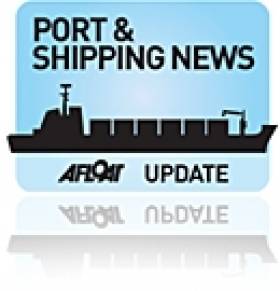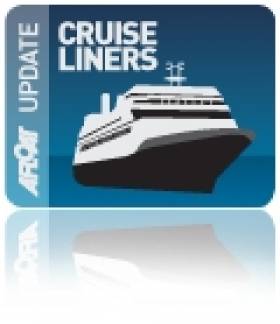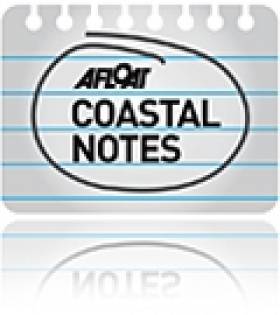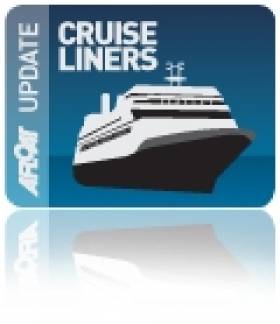Displaying items by tag: Dun Laoghaire Harbour
Dun Laoghaire's Wild West Pier Has Them Foxed
#dlharbour – Locals like to think of Dun Laoghaire's West Pier as being like a bit of Ireland's Atlantic seaboard, rugged and untamed in contrast to the smooth expression of urban order which is the East Pier.
This week, while researching the western half of the harbour for the Sailing on Saturday blog which will feature Dun Laoghaire developments in detail on January 25th, we found dramatic evidence that this is where the wild things are. A fox was strolling along beside the inner harbour as easy as you please.
But in fact, meeting the fantastic Mr Fox was evidence of the urban nature of the entire harbour. And it's encouraging for those who like to think of Dun Laoghaire as Ireland's Brighton. Apparently, Brighton is reckoned fox paradise in the south of England. It has a population of at least twenty foxes per square kilometre. And that's not counting the two-legged ones who run the many antique shops and art galleries...

Are you really sure the road is clear?
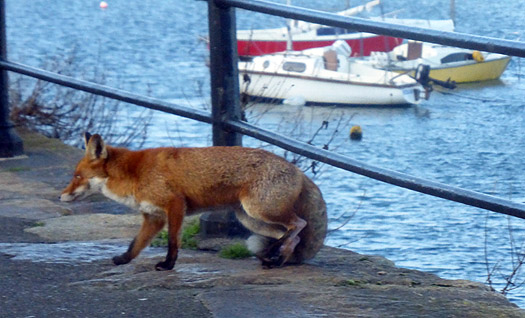
We'll just hang out here, and pretend to be interested in that Leisure 17
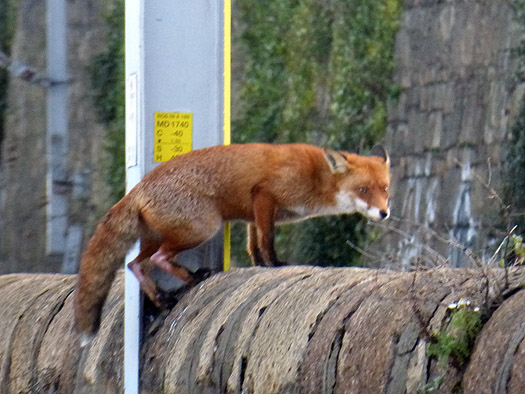
This place is getting too crowded with the wrong sort of people. Time to get in the right side of the tracks. All photos W M Nixon
Click here for the blog by WM Nixon featuring Dun Laoghaire developments
Not Quite the Full Pint as Further Tanks Arrive for Guinness Plant
#GuinnessTanks - Loaded with fermentation tanks for Guinness, Thamesteel I (1989/1,984grt) picked up a pilot in Dublin Bay as she approached Dun Laoghaire Harbour this evening, writes Jehan Ashmore.
It transpires that this extra shipment of the stainless steel fermentation tanks weighing up to 30 tons each are required for the €153m plant upgrade at the Guinness St. James's Gate Brewery facility in central Dublin.
Thamesteel I had sailed from Rotterdam-Maasvlakte from where previous shipments were discharged by a trio of cargoship's earlier this year, the last been Blue Tune which called to Dun Laoghaire Harbour in March.
On this occasion, the Marshall Islands flagged vessel which features a telescopic wheelhouse was raised due to the large cylindrical tanks positioned as deck cargo on the cargo hatch covers.
She berthed at Carlisle Pier from where the pilot was transferred back to the Camac, a Dublin Port pilot cutter built by Cork Harbour based Safehaven Marine.
Dun Laoghaire Harbour to Appoint Consultants for New Cruise Berths
#NEWCruiseBerths - Dún Laoghaire Harbour Company, acting on behalf of the Dún Laoghaire Cruise Stakeholder Group, are to appoint a Multi-disciplinary Consultancy Team for the provision of cruiseship facilities.
The proposed facilities are to attract cruisehips to make a port of call in this developing market which forms as a key element of the Dún Laoghaire Harbour Masterplan.
As reported yesterday, the new chairperson of Dun laoghaire Harbour Company board, Eithne Scott Lennon, has been an active member of the board since 1994 and played a significant role in the development of the Masterplan.
The Multi-disciplinary Consultancy Team is to provide professional services in order to carry out all planning and preliminary engineering design for the required new berth and supporting facilities.
In addition consultants are required to prepare the planning application and accompanying EIS, and to manage the planning consenting process through to completion.
For further information regarding the Cruise Berth Project Brief (download the PDF) or visit www.etenders.gov.ie
Dun Laoghaire County Manager Seeks Funding Approval to Development of New Super-Cruiser Berths
#CruiseLiners – The Irish Times reports that the outgoing county manager of Dún Laoghaire Rathdown County Council is to seek approval to spend more than €7 million on various projects among them the development of berthing facilities for super-cruisers in Dún Laoghaire Harbour.
Owen Keegan, who will take up his new post as Dublin city manager on Tuesday, will seek to cement his seven-year legacy in the county by ensuring funding for certain projects is secured before his departure on the preceeding Monday.
In a report to Dún Laoghaire councillors in advance of Monday's meeting, Mr Keegan said 12 cruisers had called at Dún Laoghaire this year, bringing 27,000 visitors, and Irish ports had attracted 220 cruise calls in 2012. But Dublin was missing out because neither the city's port nor Dún Laoghaire could accept ships of more than 300m in length.
The council had been assisting Dún Laoghaire Harbour Company in developing the port as a destination for cruise ships, he said, and the next stage would involve developing plans for a new cruise facility and applying directly to An Bord Pleanála for planning permission through the strategic infrastructure development process.
The cost of the plan is €650,000 and Mr Keegan is to seek approval for the council to contribute €250,000.
L.E. Emer to Make Final Farewell Visit to Dun Laoghaire Harbour
#FarewellEMER – L.E. Emer (P21) the oldest member of the eight-strong Naval Service fleet is to make her final scheduled visit to Dun Laoghaire Harbour tomorrow, writes Jehan Ashmore.
As previously reported, L.E. Emer is making her final patrol before she de-commissioning on 20 September. The offshore patrol vessel (OPV) will go for sell unless previously sold at a public auction to be held on 23 October. A sister, L.E. Aoife (P22) will likewise be disposed a year later.
Tomorrow (Sunday) afternoon L.E. Emer will be open to public tours while she is berthed alongside the Carlisle Pier. As previously reported the five-masted cruiseship Wind Surf is today docked at this same pier having sailed from Portrush via the Isle of Man.
Potential interest for the naval vessels could include the conversion of the ships for the superyacht market or use for the offshore energy supply sector or a research vessel.
They are to be replaced by a pair of larger 'Roisin' class OPV's currently under construction by Babcock Marine in Appledore, north Devon.
L.E. Emer was completed in 1978 followed by L.E. Aoife in 1980 at the Verolme Cork Dockyard (V.C.D.). Also launched from the shipyard in Rushbrooke near Cobh, the youngest sister L.E. Aisling (P23) which will remain in service.
As leadship of a trio of 'Emer' class Coastal Patrol Vessels (CPV) the series however in more recent years were re-classified as Offshore Patrol Vessels.
They are an improved version of L.E. Deirdre (P20) which was the first custom-built vessel for the Naval Service when launched from V.C.D. in 1972. She was de-commissioned in 2001 and sold for €190,000 and converted into a luxury yacht.
Seasonal Finale to Seafront Memorial Tours
#SeaFrontTours–The final Seafront Memorials Tour of the season ends this Sunday (1 September) in Dun Laoghaire Harbour and from where the waterfront is lined with historical landmarks.
Dun Laoghaire-Rathdown County Council which organises the free historical tours that have been running for six years as part of the Summer of Heritage Programme.
The free 1-hour tour starting at 11.30am covers coastal memorials to include the Queen Victoria Fountain, George IV Memorial, the mailboat R.M.S. Leinster's anchor, the Crimean War Cannon and the 1895 Lifeboat Disaster.
Tours start at the Queen Victoria Fountain (close to DART station) in Dún Laoghaire and the maximum number of people for each tour is 20 persons.
The outdoor event is also wheelchair accessible. No pre-booking is required and places are limited so it is advisable to turn up early.
For information Tel: (01) 204 7011 or visit www.dlrevents.ie/heritage2013.html
Queen Elizabeth Cruise Liner: Celebrating the Luxury of Art Deco
#QueenElizabeth – Queen Elizabeth's maiden visit off Dun Laoghaire Harbour today presented a wonderful sight, not to mention her impressive and sumptuous art-deco style interiors which pay homage to the legendary 1930's Cunard Ocean Liner RMS Queen Elizabeth, writes Jehan Ashmore.
The 'Vista' class 90,901 tonnes cruiseship, is the newest of the Cunard Line fleet and she was commissioned in 2010 and named by Queen Elizabeth II in Southampton. A portrait of the monarch by Isobel Peachey hangs in the splendid foyer of the Grand Lobby.
Captain C. Wells has command of the vessel with 2,040 guests which is close to her capacity of 2,100 passengers and almost 1,000 crew members. On the cruise of British and Irish ports which set off from Southampton at the end of July, the majority of the guests are from the UK and United States in addition to around 150 Germans who boarded in Hamburg.
Her guests can expect high standards with the history and pedigree of Cunard Line and among the features on Queen Elizabeth are the Grand Lobby with its magnificent mural of her 1930's predecessor. There are eight restaurants, two theatres, three swimming pools and a games deck, together with a large spa and fitness centre, shopping arcade, libraries, bars, cafés, and a casino.
The library with 7,000 books is the second largest floating library in the world after Queen Mary 2 and there's also an art gallery with paintings by Irish artist Philip Gray. In addition to those who fancy a cigar one can decline to the intimate wood-panelled surroundings of Churchill's Lounge sited high above the seas.
The Queen's Room Photo: Jehan Ashmore

The Grand Lobby Photo: Jehan Ashmore
In essence the cruiseship exudes luxury that respects the golden day era of liners whilst also combining the many wonderful modern day comforts to which cruise-goers also demand.
Queen Elizabeth is due to weigh anchor 21.00hrs this evening and after a day spent at sea her next port of call is St. Peter Port, Guernsey before her return to Southampton
Dun Laoghaire Harbour Seeks New Cruise Liner Quay
#cruiseliner – Dún Laoghaire Harbour Company (DLHC) is seeking to build a new quay inside the east coast harbour to facilitate to cater for a growing number of cruise liners calling to the capital's waters.
DLHC announced this morning it is working with the Dún Laoghaire Cruise Stakeholder Group to 'engage in an energetic marketing campaign to enable Dún Laoghaire to tap into the lucrative cruise market' coming to Dublin Bay.
Nearby Dublin Port handles the vast bulk of cruise liner traffic into Dublin and it also has plans to develop Dublin Harbour to cater for the massive vessels. In 2011, it announced plans for a new cruise terminal at the city centre port.
As part of the Stakeholder Group work, Dún Laoghaire Harbour Company has initiated a pre-application consultation with An Bord Pleanála under Section 37 of the Planning and Development Act, 2000, in regard to proposals for the construction of a new quay in Dún Laoghaire Harbour to cater for vessels of up to c.340m long. This, says DLHC, will ensure that the harbour is also capable of catering for the 'new generation' of larger cruise vessels.
P&O Cruises Calls Again As Oriana Arrives on Anchorage Visit
#CruiseAnchorage - P&O Cruises Oriana anchored this morning off Dun Laoghaire Harbour and marks another visit of the famous company following fleetmate Arcadia which called earlier this month, writes Jehan Ashmore.
Oriana with a capacity for almost 2,000 passengers was completed in 1995 and the Bermuda-flagged 69,840 tonnes cruiseship had sailed overnight through the Irish Sea under the command of Captain D. Pembridge who has charge of the adults-only cruiseship.
The gloriously favourable weather conditions which saw passengers swimming during Arcadia's visit has somewhat diminished, however Oriana still offers a choice of three pools and four whirpool spas.
Guests can also avail of the many on board facilities and after taking an excursion ashore to Dun Laoghaire Harbour or trips to the capital and the neighbouring countryside, an appetite will invariably build-up. One option is The Marco Pierre White Ocean Grill restaurant situated in the sumptuous surroundings of the Curzon Room.
Wind Surf Cruise Liner Under Sail from Dun Laoghaire Harbour
#WindSURF – As the five-masted Wind Surf departed Dun Laoghaire Harbour yesterday evening she began setting her sails, in stark contrast to her sister Club Med 2 as previously reported which presented only a forest of masts, writes Jehan Ashmore.
Firstly the foresail was raised as the 162m/535ft Wind Surf approached the harbour mouth and in quick succession the remaining sails where set using a self-unfurling computer-operated system from the masts that each tower 50m/164ft high. There are seven triangular sails totalling 2,600sq.m/26,881sq.feet
On board the 14,745 tonnes former Club Med I where new guests numbering 300 who had embarked in Dun Laoghaire Harbour at the Carlisle Pier. Wind Surf was making a turnaround port of call having arrived in the morning to dis-embark 280 passengers from a cruise starting in Portsmouth. Today the vessel is berthed in Belfast as part of a 7-day Gaelic Explorer cruise.
The awarding winning Wind Surf is the largest vessel in the five-strong Windstar Cruises and she launched in 1998 for then owners Club Med at a shipyard in Le Havre. She has luxurious amenities for 312 guests and with a crew of 191 that operates cruises mostly in the Mediterranean and Caribbean.



























